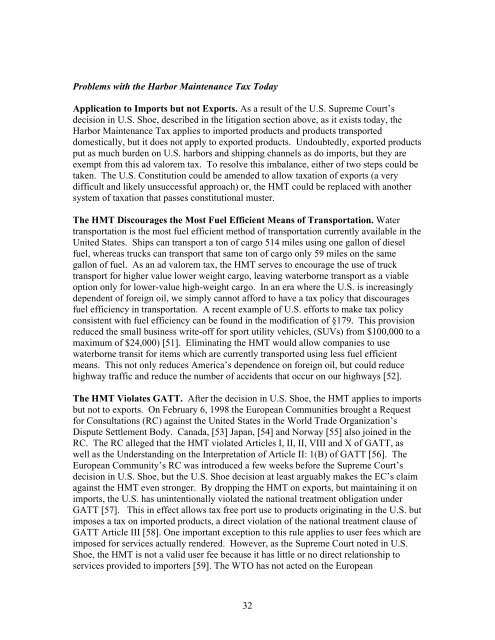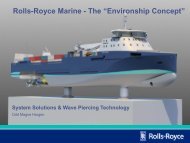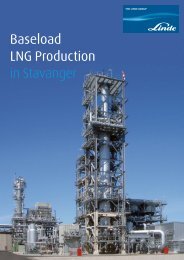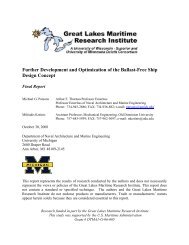15 MB - Great Lakes Maritime Research Institute
15 MB - Great Lakes Maritime Research Institute
15 MB - Great Lakes Maritime Research Institute
Create successful ePaper yourself
Turn your PDF publications into a flip-book with our unique Google optimized e-Paper software.
Problems with the Harbor Maintenance Tax TodayApplication to Imports but not Exports. As a result of the U.S. Supreme Court’sdecision in U.S. Shoe, described in the litigation section above, as it exists today, theHarbor Maintenance Tax applies to imported products and products transporteddomestically, but it does not apply to exported products. Undoubtedly, exported productsput as much burden on U.S. harbors and shipping channels as do imports, but they areexempt from this ad valorem tax. To resolve this imbalance, either of two steps could betaken. The U.S. Constitution could be amended to allow taxation of exports (a verydifficult and likely unsuccessful approach) or, the HMT could be replaced with anothersystem of taxation that passes constitutional muster.The HMT Discourages the Most Fuel Efficient Means of Transportation. Watertransportation is the most fuel efficient method of transportation currently available in theUnited States. Ships can transport a ton of cargo 514 miles using one gallon of dieselfuel, whereas trucks can transport that same ton of cargo only 59 miles on the samegallon of fuel. As an ad valorem tax, the HMT serves to encourage the use of trucktransport for higher value lower weight cargo, leaving waterborne transport as a viableoption only for lower-value high-weight cargo. In an era where the U.S. is increasinglydependent of foreign oil, we simply cannot afford to have a tax policy that discouragesfuel efficiency in transportation. A recent example of U.S. efforts to make tax policyconsistent with fuel efficiency can be found in the modification of §179. This provisionreduced the small business write-off for sport utility vehicles, (SUVs) from $100,000 to amaximum of $24,000) [51]. Eliminating the HMT would allow companies to usewaterborne transit for items which are currently transported using less fuel efficientmeans. This not only reduces America’s dependence on foreign oil, but could reducehighway traffic and reduce the number of accidents that occur on our highways [52].The HMT Violates GATT. After the decision in U.S. Shoe, the HMT applies to importsbut not to exports. On February 6, 1998 the European Communities brought a Requestfor Consultations (RC) against the United States in the World Trade Organization’sDispute Settlement Body. Canada, [53] Japan, [54] and Norway [55] also joined in theRC. The RC alleged that the HMT violated Articles I, II, II, VIII and X of GATT, aswell as the Understanding on the Interpretation of Article II: 1(B) of GATT [56]. TheEuropean Community’s RC was introduced a few weeks before the Supreme Court’sdecision in U.S. Shoe, but the U.S. Shoe decision at least arguably makes the EC’s claimagainst the HMT even stronger. By dropping the HMT on exports, but maintaining it onimports, the U.S. has unintentionally violated the national treatment obligation underGATT [57]. This in effect allows tax free port use to products originating in the U.S. butimposes a tax on imported products, a direct violation of the national treatment clause ofGATT Article III [58]. One important exception to this rule applies to user fees which areimposed for services actually rendered. However, as the Supreme Court noted in U.S.Shoe, the HMT is not a valid user fee because it has little or no direct relationship toservices provided to importers [59]. The WTO has not acted on the European32












